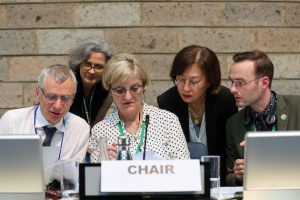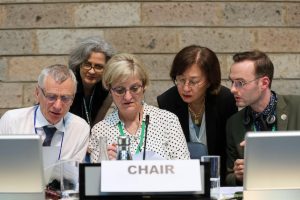Biodiversity Meet Suggests New Guidelines on Synthetic Biology Amid Persisting Questions
 20 Mei 2024
20 Mei 2024

SBSTTA 26 Chair Senka Barudanović, Bosnia and Herzegovina, conferring with the Secretariat. Credit: IISD/ENB | Mike Muzurakis
By Stella Paul
NAIROBI, May 20 2024 (IPS)
After a week-long discussion by delegates from 196 countries, the 26th meeting of the Subsidiary Body of Scientific, Technical, and Technological Advisors (SBSTTA) of UN Biodiversity has concluded with a set of recommendations on several issues, including living modified organisms (LMOs) and synthetic biology. All nations must consider the recommendations, discuss them, and possibly adopt them at the Biodiversity COP in October. However, many questions remain unanswered and unclear.
LMOs and Synthetic Biology in Biodiversity COP
Synthetic biology, though identified as a new emerging issue, has been discussed for well over a decade at UN Biodiversity. In fact, 13 years ago, at COP11 in Hyderabad, India, nations took note of the proposals for new and emerging issues relating to the conservation and sustainable use of biodiversity. They had also noted the need to consider the potential positive and negative impacts of components, organisms and products resulting from synthetic biology techniques on the conservation and sustainable use of biodiversity.
Based on SBSTTA’s suggestions, countries decided to create an ad hoc technical expert group (AHTEG) on synthetic biology in 2014. This group would talk about “synthetic biology as a further development and new dimension of modern biotechnology that combines science, technology, and engineering to make it easier and faster to understand, design, redesign, manufacture, and/or modify genetic materials, living organisms, and biological systems.” Later, the COP also asked AHTEG to discuss synthetic biology and risk assessment under the Cartagena Protocol on Biosafety, an international agreement aimed at ensuring the safe handling, transport, and use of living modified organisms (LMOs). The protocol was adopted on January 29, 2000, as a supplementary agreement to the Convention on Biological Diversity (CBD) and entered into force on September 11, 2003.

David Cooper, acting Executive Director of UN Biodiversity and Senka Barudanovic, SBSTTA chair, address the press. Credit: Stella Paul/IPS
The Mandate of SBSTTA-26
Brinda Dass is the Gene Drive Policy Lead at Foundation for the National Institutes of Health, US and a member of the AHTEG who attended the SBSTTA-26 in Nairobi. Dass revealed that for the Nairobi meet, AHTEG was given the task of developing a special guideline on engineered gene drive and at SBSTTA, the major discussion on LMO and synthetic biology was centered around genetically modified mosquitoes.
“For risk assessment, the request from the last COP (COP15 held in Montreal, Canada, in 2022) was to have a draft outline prepared. The request was very focused on the specific elements of engineered gene drive mosquitoes because that’s the most proximal use case because there’s work ongoing right now to generate engineered gene drive mosquitoes for malaria elimination and control in Africa. So, our technical expert group was asked to prepare additional voluntary guidance on living modified organisms that contain engineered gene drives—and that’s what we did,” Dass told IPS.
Dass’s also commented that it was a successful meeting.
“Most parties, especially from the African continent—actually, almost all African delegations—accepted the document as they were happy to send it to the COP. So, they have approved it, they have accepted it, they were happy with what work was done and they wanted to move to COP. They don’t have any reservations on that,” Dass added.
Both Senka Barudanovic, who chaired all the sessions of SBSTTA and David Cooper, acting Executive Secretary of UN CBD, appeared to agree with Dass.
“I sincerely congratulate delegates for their hard work; I think it was a successful meeting where most parties demonstrated a spirit of compromise,” said Barudanovic.
“This meeting showed the willingness of parties to the CBD to reach consensus on the important scientific foundations of our work to achieve the Biodiversity Plan,” said Cooper. “The discussions have wide-reaching implications for biosafety, biotechnology, biodiversity in our oceans, and new global work on the health of people, plants, and animals.”

Brinda Dass, senior technical expert and Gene Drive Policy Lead at the Foundation for the National Institutes of Health. Credit: Stella Paul/IPS
Engineered Gene Drive Versus Genetically Engineered Products
Genetic engineering involves the direct modification of an organism’s DNA, often in a controlled environment, without necessarily influencing inheritance patterns in the wild. This technology is usually applied in agriculture, medicine, and industrial biotechnology. For example, BT cotton and other genetically modified (GM) crops.
Engineered gene drive, on the other hand, uses specific genetic constructs to create inheritance patterns, which means the genetic modification has a higher chance of being passed on from one generation to another. The development of engineered malaria mosquitoes is done under this technology.
Since its impact would be on successive generations, engineered gene drive technology naturally raises significant ecological and ethical concerns due to the potential for widespread and irreversible impacts on ecosystems and biodiversity. One of the biggest concern is the potential spread of modified genes beyond the target population. For example, there is concern about the impact and effect of engineered gene drive malaria-resistant mosquitoes on other animals and other insects, including mosquitoes that do not cause malaria.
Experts also say that the whole issue of LMO and Synthetic Biology is also looked at with concern and skepticism because many find it too complicated.
One of the reasons that it is complicated is because there is no universal definition of what synthetic biology is. Because it largely captures many kinds of technologies and products, it is difficult to understand what does and doesn’t fall under the bucket of synthetic biology.
Another factor is the unequal participation of the delegates, which could be attributed to a variety of reasons, including lack of understanding.
“Not all the delegates speak up. So, we don’t know their level of understanding. By level of understanding, I mean, there’s factual understanding and then there’s understanding of what the implications are of the decisions that are being taken here. Of course, I can’t say more (on the reasons why they don’t speak or their understanding), because I don’t know all the delegates and I’m limited to their statements,” said a scientist from the US who works as the focal point on LMO but is unwilling to reveal his name as the US is not a signatory to the UN Biodiversity Convention.

Lucia DeSouza, senior biotechnology scientist at the Public Research and Regulation Initiative (PRRI). Credit: Stella Paul/IPS
The Arguments and the Questions
At SBSTTA, some participants indicated that despite days of discussions, several questions were left unanswered and that many parties and representatives of NGOs and indigenous peoples groups were not in agreement. Some of these experts have been following the biodiversity COPs, the developments at SBSTTA, and the Cartagena Protocol for a long time, and they allege that the issue of gene drive was being discussed at multiple meetings, which led to unnecessary use of time, efforts, and resources.
“If you look at the documents from synthetic biology, one of the things that they prioritize is gene drives. But the thing is that gene drive is also being looked at already under Cartagena protocol. So, if you ask me, it looks like duplication of effort because synthetic biology is supposed to do horizon scanning, which is to look at new and emerging technologies as they apply to CBD and the protocols, right? So, if they look and say gene drive is one of those technologies,. But then, we already have gene drives being worked on, it’s not so much new and emerging,” said a scientist unwilling to reveal her name as she is not authorized to speak with the media.
The same issue was also brought up by the delegate from Japan, who argued that gene drive technology is a technology that arrived several years ago. It has already emerged, and the world is already working on it. So, why was the issue still being discussed at SBSTTA as a new and emerging issue?
“It’s true; technical experts have been talking about synthetic biology for more than 10 years, but they never concluded whether it is a new and emergent issue. Even the self-limiting mosquitoes fall under the definition of LMO and it’s one that has been tested in the field for a long time and it’s actually approved for Brazil, Paraguay, if I’m not mistaken. So, it’s also even been in the market. So, what Japan here raised is a very important point, because we are wasting a lot of time,” says Lucia DeSouza, a Brazilian scientist who is the Executive Secretary of the Public Research and Regulation Initiative (PRRI), a global group of biotechnology scientists.
Recommendations of SBSTTA and the Future Course
According to a statement by the CBD Secretariat, on biosafety and biotechnology, the Parties recommended new voluntary guidance on the risk assessment on engineered gene drives. The recommended guidelines are aimed at strengthening transparency and scientific rigor in the process and continuing the detection and identification of LMOs.
For the issue of synthetic biology, SBSTTA recommended that further discussions are needed on the possibility of continuing horizon scanning, an approach that involves systematically exploring and analyzing emerging trends, innovations, and potential future developments in the field of synthetic biology. This approach helps policymakers, researchers, and stakeholders anticipate and prepare for future challenges and opportunities.
An example of horizon scanning for synthetic biology could be the development of genetically modified fish, which is currently being researched for possible aquaculture efficiency and food security.
However, because SBSTTA is an advisory group, the COP may or may not adopt its recommendations. But once a draft decision is sent to the COP—in this case the issue of engineered gene drive malaria mosquitoes—then the nations will have a chance to read and express their opinions. It is possible that they will object to or reject some of the draft’s provisions, but it is also very likely that the parties will eventually accept some version of the draft decision.
“We are discussing risk assessment. We are discussing how to build a management system based on this risk assessment. And then what? Then, where do we go? It’s a good question,” DeSouza said. “While we can’t predict where things will go from here, as long as this topic remains relevant for parties, they’re going to keep wanting to have conversations related to it. The only way the topic will end is if the products (like gene drive mosquitoes) stop being produced and used or if the parties stop taking an interest in it. If the parties stay interested, then SBSTTA will continue to develop technical guidance documents. Finally, the countries will develop their own domestic regulatory frameworks following all these guidelines and the Cartagena protocol.”
IPS UN Bureau Report
